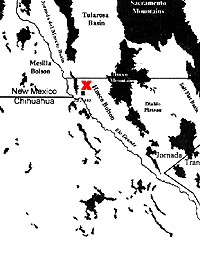
Major geographical features in the area.
The red X marks the location of Firecracker Pueblo.
Click images to enlarge
|
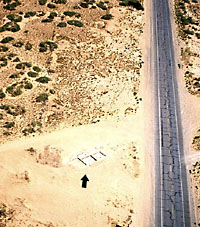
Aerial view of Firecracker Pueblo taken
in 1980 after the first rooms were exposed. Across Highway
54 is an abandoned fireworks stand that gave the site its
name.
|
|
Firecracker pueblo was abandoned in the late fifteenth
century and is, in fact, one of the latest examples of a Jornada
Mogollon pueblo known.
|
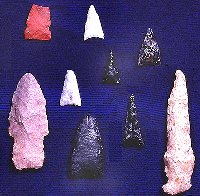
The projectile points found at Firecracker
represent raw materials from local sources. The small
triangular arrow points were made and used by the pueblo
occupants, but several of the larger, side-notched points
are dart points from earlier cultures perhaps picked
up as curiosity items.
|
|
In the early fifteenth century, farmers in the Hueco
Bolson near modern day El Paso, Texas, established a small village
or hamlet probably near their corn and bean fields. They were part
of the Jornada Mogollon culture and lived during the latter part
of what is called the El Paso phase or Pueblo period. But instead
of building a pueblo, they first constructed the type of house used
by their ancestors: pithouses. The small pithouse village was probably
lived in only during certain seasons of the year when the farmers
needed to tend nearby crops.
The investigations at Firecracker Pueblo produced
the first definitive evidence that pithouse structures resulted
from short-term or seasonal occupation by puebloan peoples.
Earlier researchers thought that all pithouses dated to earlier
periods. Pithouse rooms, such as the one from Firecracker
that is shown on the right, have now been found at other sites
in the region. Although smaller than most pueblo habitation
rooms, Room 13 has many of the same characteristics: a plastered
hearth, caliche-plastered floor, and post holes. After it
was used for habitation, it was apparently turned into a storage
room. It was then that the perishable roof and upper walls
caught fire and the contents of the room burned. A layer of
burned materials including charred shelled and cob corn, beans,
and gourds was found directly on the floor.
Soon the pithouses were replaced by a more substantial
adobe pueblo that grew to 16 rooms or so, some of them habitation
rooms and others used for storage. The rooms in the pueblo were
larger than the pithouse rooms, but had many of the same features
including a small plastered hearth near each doorway. Outside the
pueblo archeologists found many pits and activity areas such as
small cooking hearths, trash dumps, large roasting pits, and borrow
pits dug to obtain adobe and caliche building materials.
But the most enigmatic finds were dozens of
cylindrical pits, some small and some large. These are now
believed to be storage pits where surplus food—probably
corn and beans—was stored during periods when people
were not living at Firecracker. If this interpretation is
correct, fifteenth century farmers were much more mobile than
was previously thought. Perhaps this reflects the difficulty
that farmers had during this period.
Firecracker pueblo was abandoned in the second half
of the fifteenth century and is, in fact, one of the latest Jornada
Mogollon pueblos known. All across the Southwest and northern Mexico,
the fourteenth and fifteenth centuries were times of great change.
Centuries-old traditions apparently came to a fairly rapid end within
a few generations as large and small pueblos were abandoned. These
changes were probably caused by a variety of factors including overpopulation,
overspecialization in agriculture, and climatic shifts to drier
and less predictable conditions.
In this exhibit you can learn more about the Jornada
Mogollon and Firecracker Pueblo. The site was excavated over a 10-year
period by numerous volunteers including members of the El Paso Archeological
Society and the Texas Archeological Society, as well as students
at UT El Paso. Many people who noticed the excavations as they drove
by Highway 54 north out of El Paso joined the effort as well. The
many years of hard work at Firecracker Pueblo produced long lessons
and big surprises.
You might want to start by reading about the Jornada
Mogollon and then the Introduction
to Firecracker Pueblo.
Cattails growing in marshy area below Los Tules, New Mexico. Prior to modern agriculture and reservoir construction,
marshes were formerly present along much of the Rio Grande Valley. Many of the largest and most intensively occupied
Jornada Mogollon pueblos are located along the river.
|
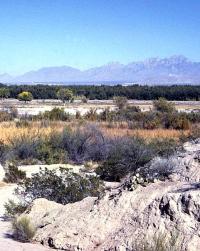
View across Rio Grande Valley from
a pithouse village located on an alluvial fan near Los
Tules, New Mexico. Organ Mountains in background.
|
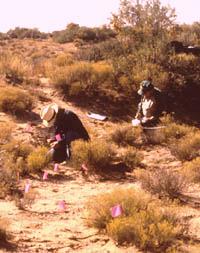
Archeological crew mapping surface artifacts as part of
a highway project in the interior of the Hueco Bolson.
|
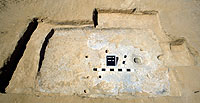
Room 13, a shallow pithouse, was
part of a small pithouse village that immediately preceded
the pueblo.
|
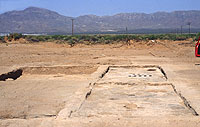
Looking west across the first four
rooms of pueblo to be excavated.
|
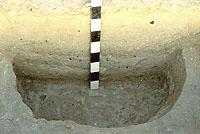
Feature 1, a good example of one
of the most common and enigmatic outside features is
a cylindrical pit with a flat bottom. These were frequently
trash-filled, and sometimes contained cached grinding
stones. These pits were likely used for concealed storage
during periods of short-term or seasonal abandonment
of the site. By matching broken artifacts, it was learned
that most of these features were used during the occupation
of the pueblo and not that of the pithouses.
|
|

